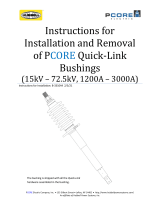
Maintenance
Frequency of maintenance
Because reclosers are applied under widely varying
operating and climatic conditions, periodic inspection and
routine maintenance are best determined by the user, based
on actual operating experience. Routine maintenance should
be performed at a minimum of fifteen years.
To assure proper and trouble-free operation, reclosers must
be maintained when they have operated the equivalent of
twice the rated duty cycle, refer to Table 5.
In the absence of specific operating experience, routine
maintenance should be performed on Types V4L and V4E
vacuum reclosers at a minimum of fifteen (15) years.
CAUTION
This equipment requires routine inspection and
maintenance to ensure proper operation. If it is not
maintained, it can fail to operate properly. Improper
operation can cause equipment damage and possible
personal injury. G105.1
Periodic inspection and maintenance
Each periodic inspection of the recloser should include at
least the following steps. Use all locally approved safety and
operating procedures. Bypass recloser to perform Step 1D.
1. Check the following external components:
A. Check for damages to arresters, arrester brackets,
by-pass switches, and high voltage connections.
B. Check for broken bushings, flashover damage,
significant signs of rust at the head or tank, oil
residue/leaks, other mechanical damage. Replace
or repair if necessary.
C. Record counter reading in recloser record log.
D. Open and close the manual operating handle
(counter advances on the trip/open operation)
to test operation of counter. Replace counter
ifnecessary.
2. Return the unit to service.
Routine maintenance
Preparation
CAUTION
Equipment damage. Recloser must be open (yellow
operating handle, under sleethood, down) before
untanking. Tripping the mechanism out of oil will cause
excessive mechanical shock to the operating mechanism,
which will cause accelerated wear and/or damage to the
mechanism. T202.0
1. Remove mechanism from tank. Loosen four bolts that
secure tank to head casting, and loosen gasket seal
between tank and head casting. Gasket seal can be
broken by carefully prying head and tank apart.
2. Hoist mechanism out of tank; allow oil to drain off
ofmechanism.
3. Inspect and clean all internal components, as required.
CAUTION
Dielectric failure, equipment damage. Never use volatile
solutions, detergents, or water-soluble cleaners when
cleaning the interior of this equipment. These cleaners
will contaminate the insulating oil, reducing its dielectric
strength. Operation with contaminated insulating oil can
result in internal flashovers that will cause equipment
damage and possible personal injury. T201.2
Bushings and bushing gaskets
4. Clean the bushing thoroughly and examine carefully for
cracks, or other damage, while the recloser is untanked
for servicing. Cracked or damaged bushings must be
replaced. Refer to bushing changeout section.
5. Disconnect appropriate bushing lead, see Figures 2
and 3.
6. Remove three hex-head cap screws and bushing
clamps that secure bushing to head casting. Lift
bushing assembly from head.
7. Install new lower bushing gasket.
8. Position aluminum clamping ring so split will be
centered between two clamping bolts.
9. Replace bushing clamps and tighten cap screws evenly,
a little at a time, to 6-10 lbs-ft (8-13 Nm).
10. Reconnect bushing lead and tighten.
11. Upper terminal gaskets should not need replacing. Do
not attempt to disassemble the V4E oil-filled bushings.
12. Remove old oil, drain tank and dispose of according
to local regulations. Wipe tank walls and bottom with
clean lint free cloth. Low dielectric strength usually
indicates presence of water or carbon deposit.
13. Install new inner tank liners.
ote:N Two liners are used. The inner liner is fibrous and
readily absorbs any moisture present. Soft or spongy
areas indicates that water has been absorbed.
14. Fill tank with new, clean transformer oil:
A. Use oil with dielectric strength of at least 30 kV,
as measured across a standard 0.1 inch (2.54 mm)
gap in accordance with methods illustrated in
ASTM Publication D117.
Types V4L and V4E single-phase maintenance instructions
2 MAINTENANCE INSTRUCTIONS MN280055EN May 2017




















